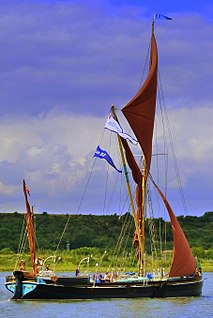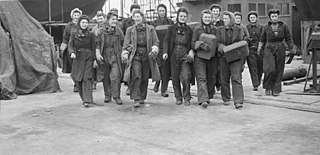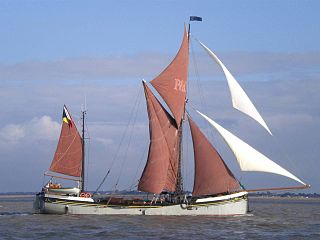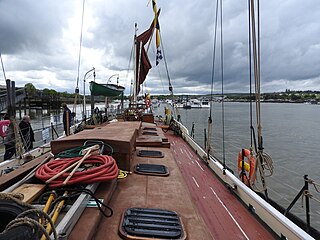
A Thames sailing barge is a type of commercial sailing boat once common on the River Thames in London. The flat-bottomed barges with a shallow draught and leeboards, were perfectly adapted to the Thames Estuary, with its shallow waters and narrow tributary rivers. The larger barges were seaworthy vessels, and were the largest sailing vessel to be handled by just two men. The average size was about 120 tons and they carried 4,200 square feet (390 m2) of canvas sail in six working sails. The mainsail was loose-footed and set up with a sprit, and was brailed to the mast when not needed. It is sheeted to a horse, as is the foresail; they require no attention when tacking. The foresail is often held back by the mate to help the vessel come about more swiftly.

The PS Oscar W is a restored paddle steamer located at Goolwa in South Australia.

SS Nomadic is a former tender of the White Star Line, launched on 25 April 1911 in Belfast now on display in Belfast's Titanic Quarter. She was built to transfer passengers and mail to and from RMS Olympic and RMS Titanic. She is the only surviving vessel designed by Thomas Andrews who also designed those two ocean liners, and the only White Star Line vessel in existence today.

Arthur Foss, built in 1889 as Wallowa at Portland, Oregon, is likely the oldest wooden tugboat afloat in the world. Its 79-year commercial service life began with towing sailing ships over the Columbia River bar, and ended with hauling bundled log rafts on the Strait of Juan de Fuca in 1968. Northwest Seaport now preserves the tug as a museum ship in Seattle, Washington.

PS Lincoln Castle was a coal-fired side-wheel paddle steamer, which ferried passengers across the Humber from the 1941 until 1978. She was the last coal-fired paddle steamer still in regular services in the UK. Later, she served as a pub at Hessle, and then as a restaurant under permanent dock at Alexandra Dock, Grimsby. In September 2010, the Hull Daily Mail reported that she was in an advanced state of demolition, despite the efforts of local people to buy the historic vessel and restore her. On 31 March 2011, the Lincoln Castle Preservation Society were reported to have purchased the broken up parts of the ship for restoration.

Beverley Beck is a short canal in the East Riding of Yorkshire, England. The beck runs from Grovehill Lock on the River Hull at Beverley west for about 0.8 miles (1.3 km) into the town of Beverley. Until 1802, the beck was tidal, but the Beverley and Barmston Drain needed to pass under it, and the lock was constructed to maintain water levels over its tunnel. In 1898, a steam engine was installed, which could be used to top up the water levels in the beck by pumping water from the River Hull. A multimillion-pound refurbishment of the area concluded in 2007, with the refurbishment of the lock gates and pumping engine.

Baltimore is a preserved steam-powered tugboat, built in 1906 by the Skinner Shipbuilding Company of Baltimore, Maryland. She is formerly the oldest operating steam tugboat in the United States, but at present does not hold an operating license issued by the US Coast Guard, so is unable to leave her dock at the Baltimore Museum of Industry on Key Highway, Baltimore. Her hull is not capable of operating on open water. Baltimore was built and operated as a harbor inspection tug, capable of acting as a municipal tugboat for city barges, as well as an official welcoming vessel and VIP launch, an auxiliary fireboat, and as a light icebreaker.

MV Celtic is a former Thames sailing barge which was built by Kievits & Van Reede in Papendrecht, Netherlands in 1903 for E J & W Goldsmith Ltd of London and Grays, Essex. She is currently under restoration at Sittingbourne, Kent.
Dorothea Weber was a 190 GRT three-masted Schooner that was built in 1922 as the barge Lucy by J Oelkers, Hamburg. She was later renamed Midgard I, Midgard IV and then Elisabeth before a sale in 1935 saw her fitted with a diesel engine and renamed Dorothea Weber. She was seized by the Allies in May 1945 at Guernsey, passed to the Ministry of War Transport (MoWT) and renamed Empire Cononley.

Richard Dunston was a shipbuilder on the Humber, England. The company started building wooden barges miles from the sea and evolved to pioneer fully welded steel ships of a single design. The yard is now closed, although the name continues in a ship repair yard.

Henry Scarr Ltd. was an English shipbuilding company based in the East Riding of Yorkshire at Hessle on the Humber. Henry Scarr took over an existing shipyard in 1897, and continued to build ships there until 1932, when the site was bought by Richard Dunston Ltd. Dunstons operated the shipyard until 1974, and after a series of takeovers, shipbuilding ceased in 1994.

Lady of the Lea is a spritsail Thames sailing barge, the last such barge to be built in England. She was built in 1931 to carry explosives from Waltham Abbey Royal Gunpowder Mills on the River Lea to Woolwich Arsenal on the River Thames. The barge was later sold and rebuilt. She currently operates as a private yacht and competes in Thames sailing barge matches.

Will is a Thames sailing barge, built in Great Yarmouth by Fellows & Co in 1925. She is 97.6 ft (29.75 m) long, 23.1 ft (7.04 m) across and 9.6 ft (2.93 m) deep. Will Everard, as she was originally known, was commissioned as one of four steel barges; the largest ever built. She is a mulie, with a spritsail rigged mainmast, a topmast and a gaff-rigged mizzen. She has a flat bottom with leeboards as is customary for Thames sailing barges. As one of the last sailing cargo vessels to operate in UK waters she left trade in 1966. After a few years lying derelict, she was refitted and eventually entered into the service of P&O where she was used as a floating board room until 1999. This role in corporate hospitality continued and she now is fully engaged in private charter work. She currently operates out of the Pool of London from a base at Hermitage Community Moorings, Reeds Wharf and St Katherine Docks for cruises through London, the east coast and beyond.

A caisson is a form of lock gate. It consists of a large floating iron or steel box. This can be flooded to seat the caisson in the opening of the dock to close it, or pumped dry to float it and allow it to be towed clear of the dock.

SB Centaur is a wooden Thames sailing barge, built in Harwich, Essex, England in 1895. She was used to carry various cargoes, mainly grain, for the next 60 years. During the First World War she carried food and coal to the French Channel ports. During the Second World War Centaur was damaged when sailing to assist with the Dunkirk Evacuation. She did war work for the duration of the conflict.

Kitty is a wooden Thames sailing barge in the bowsprit class of 65 tons. She was built in Harwich in 1895. She is No. 209 on the National Historic Ships Register.

SB Decima is a steel Thames sailing barge constructed in Southampton in 1899 by J.G. Fay and Co, Southampton for E. J. Goldsmith of Grays, Essex. She is back under sail and resident on the River Darent in Dartford, Kent. She is a notable "Historic Ship".

SS Selah Chamberlain was a wooden hulled Great Lakes freighter that sank in Lake Michigan in 1886, 6 miles (10 km) off the coast of Sheboygan, Sheboygan County, Wisconsin, United States after being rammed by the steamer John Pridgeon Jr. with the loss of five lives. On January 7, 2019, the wreck of Selah Chamberlain was listed on the National Register of Historic Places, and was given the reference number 100003288. She was the first shipwreck listed on the National Register of Historic Places in 2019.

Blue Mermaid is a steel-hulled Thames sailing barge constructed between 2015 and 2019. She was built specifically to operate under sail and does not carry an engine. She is a replica of Blue Mermaid. She was constructed in Devon, and she was launched on 28 May 2016 for the Sea-Change Sailing Trust. She was taken to Maldon where she was fitted out at the Downs Road Boatyard. She will operate out of the Heybridge Basin.

The PV Pyap is a tourist paddle vessel operating within Swan Hill's Pioneer Settlement. Originally launched as a barge in July 1896 at Mannum, the Pyap was completed as a paddle steamer in late 1897 and operated on the Murray River. In 1970, the Pyap was purchased by Toby Henson and refitted with a diesel enginge, with the intention of relocation to the Pioneer Settlement.


















